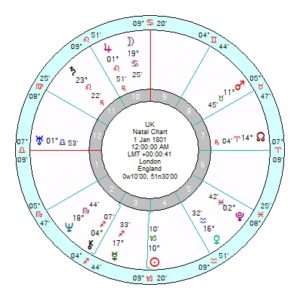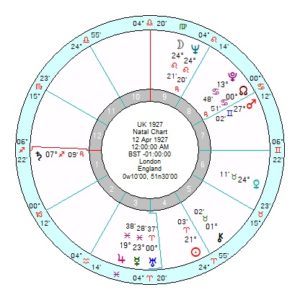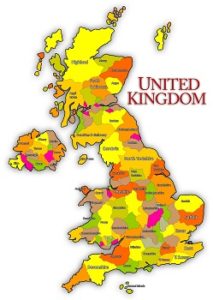I hate new dates for country charts. Often they are thrown into the mix by people who are either: a) obsessive compulsive and just like to fiddle and be different from the crowd; b) get focussed on minor shifts in the country’s history, in this instance a name change – after a divorce you don’t get a new birth chart; c) or think because the chart in accepted usage doesn’t always throw up exact predictive timings it has to be wrong, rather than accepting that astrology is highly complex. What proves to be a tipping point is the consequence of multiple influences exerting (or accompanying) pressure as they move backwards and forwards on different cycles. So an actual event can be the ‘result’ of several influences happening just before and sometimes just after. Also astrology has a different mindset. I’m not convinced it particularly cares about Derby or even election winners at times. In the grand cosmic scheme of things, these are trivia. Also a bit like divorce, most often the key events happen beforehand and sometimes after. The actual date itself isn’t always the most relevant.
That being said, all that matters is which chart throws up the best info. And against much grudging, gritting-of-teeth having tested the UK 12 April 1927 chart (when the UK changed name to add Northern Ireland) against the start of WW11, 1973 join-EEC and Brexit 2016, it isn’t bad. Oddly enough it shows up the start of World War 1 best of all – which is into minus mathematics since UK 1927 didn’t exist then. Another astrological conundrum.
The UK 1801 chart was spot on for WW11 and not bad for WW1, showing the early aftermath clearly; reasonable for EEC 1973 with outer planet Solar Arc and transits bringing jolting changes, challenges, gloom and some panic. Brexit coincided with a shocking change of direction, with a surge of empowerment and emotional angst.
The UK 1927 chart was so-so for WW11. Spot on for 1973 EEC with tr Pluto conjunct the MC and conjunct Solar Arc North Node exactly for a moment of destiny, a radical rethink of direction and ambitions with power struggles ahead. Tr Neptune was exactly conjunct the Ascendant for confusion about identity. For the 2016 Brexit vote Solar Arc Mars was exactly conjunct the Mars for a massive shock, bringing insecurity and inflamed tempers; with the Solar Arc MC opposition the Node exact, so a significant point in history.
The UK 1927/EU relationship chart is massively complex – a chained-together-and-resenting it Saturn trine Pluto but in a Fire Grand Trine it’s also entrepreneurial (good for trade); with a hard-to-balance Mystic Rectangle of an autocratic Saturn opposition Uranus sextile/trine a bitterly argumentative and stubborn Pluto opposition Mercury. There’s an unfair-treatment Mars square Saturn; and a sugary-sweet Jupiter opposition Moon square Venus. And a Half Grand Sextile Pluto opposition Mercury, sextile Uranus sextile Venus. Lots of advantages and lots of aggro.
This year is panic-stations on that chart with tr Neptune opposition Mars, extending through 2019; with an uncertain and tormented November and December this year as tr Neptune square Saturn brings neurotic fears of a total disaster. Plus tr Saturn dampening good feelings through till December as well. Where it really starts to rock on its foundations is from May 2020 as tr Uranus squares the Pluto.
The UK 1927 chart itself has a 4th house/cusp of 5th Aries Sun trine an exact Moon Neptune in Leo in the 9th, sextile Mars in Gemini – pro-active and go-ahead with dreams-of-empire from Moon Neptune in the 9th. There’s also a controlling, power-hungry Pluto in the financial 8th house in a confident trine to Jupiter. With a defensive Saturn on the Ascendant in self-righteous Sagittarius.
At the moment tr Saturn is moving through the low profile First Quadrant as it was after Suez Crisis in 1956 when the UK faced up to its loss of status as the world’s superpower; and decolonisation kicked in as tr Uranus was conjunct the 9th house Moon Neptune towards the 1960s which makes sense.
2020 hints at dashed-hopes from tr Neptune conjunct Jupiter.
In summary not bad for 1927 UK, though working with too many charts creates a muddle of too much data. All significant moments in a country’s history will have some similarities to each other and the main chart. At the end of the day you’re better to settle for one. But UK 1927 is worth keeping an eye on.




Marjorie
Having waded through a plethora of British horoscopes in the past couple of weeks and identified a few more to look at I find I am suffering chart fatigue. I can sympathise with those who think that Edward Confessors Chart is more relevant to the Norman Conquest that followed his reign than to modern Britain’s relationship with Eurocrats in Brussels. Having said that events like the Roman conquest of Britain and the aftermath of the Battle of Hastings do show how these islands relationship with the continent have fluctuated over the ages.
Personally I like the UK 1927 Chart when examining Brexit because it is recent and it represents a political and constitutional construct which echoes so many of the features of the EU The irony is that he EU and the UK are both supra national entities built around older national groups pooling sovereignty. One would have thought that would give them an instinctive understanding of each other but sadly the opposite appears to be the case.
One thing I think the charts do indicate is that there is a high likelihood that the UK will it self dissolve into its constituent parts post Brexit. The UK state was very much an ‘imperial project’ dating right back to the time of the Elizabethan John Dee who coined the term British Empire over a hundred years before the Act of Union joined England and Scotland. Now the Empire has gone the UK itself looks to be past its sell by date politically. I have myself considered this likely for about two decades but I think Brexit will be the catalyst which makes it happen. To be honest a political set up which now increasingly recognises Scottish and Welsh identity but pretends England does not exist is not tenable in the longer-term. It is fashionable to deride little Englanders but their grasp on the reality of their country’s true place in the world is probably a lot more realistic than most British politicians. It is only once that process of realigning political rhetoric to reality has completed that the British peoples relationship with Europe can be rebuilt.
It could be that this chart might be useful for understanding the relationship between the UK and Northern Ireland as a political entity, rather than superseding the previous 1801 chart which officially marked the start of the UK. When Ireland broke off from the UK, the UK didn’t cease to exist, nor was it replaced by another political entity officially.
Good thought. It certainly shows up the Irish Troubles starting late 1960s v clearly. Will think on it and maybe expand tomorrow.
Great point, indeed. This is also why EEC 1957 works well The UK relationships, while not at all as well with countries which joined when Maastrich Treaty was already established and had to comform to those norms, or European Parliament.
I agree with Andy, that’s how I looked at it too. I was thinking along the lines of the 1801 still being relevant, but the 1927 maybe describing our relationship and actions towards Ireland and Europe. I suppose that very specific country title is the one that’s on our red passports under “European Union” and it also marked the recognition of a new land border. Also, entirely personal, but intuitively the character of the chart felt a little better for those matters.
I only briefly looked for consensus between the 2 charts; 23-25 of fixed signs seems to be one, which also pops up on the EU chart so we know that’s very sensitive to the relationship. Although Marjorie, it’s sort of reassuring to know that even Virgos get data fatigue just like the rest of us 😉
I think Andy’s comment misunderstands the constitutional framework of the UK. The comment that the 1927 chart may be “useful for understanding the relationship between the UK and Northern Ireland as a political entity” is problematic at best in that the netion referred to is not “The United and Northern Ireland”, it’s “The United Kingdom of Great Britain AND Northern Ireland”, Northern Ireland IS the UK just as England, Scotland and Wales are. This comment implies that the UK engages with NI as if it is a foreign entity, not the case.
If the UK of 1927 chart is relevent, it is relevent as the chart of the whole of the UK of GB and NI, not solely for relations with NI.